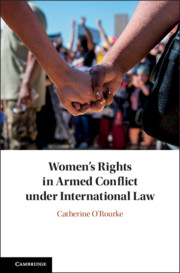Book contents
- Women’s Rights in Armed Conflict under International Law
- Women’s Rights in Armed Conflict under International Law
- Copyright page
- Dedication
- Contents
- Acknowledgements
- Tables
- Table of Treaties
- Table of Cases and Communications
- Abbreviations
- Part I Legal and Conceptual Framework
- Part II Case Studies
- 5 Women’s Rights and International Law in a Fragile State
- 6 Women’s Rights and International Law in Ending Conflict
- 7 Women’s Rights and International Law in Building Peace
- Part III Looking Forward
- Bibliography
- Index
6 - Women’s Rights and International Law in Ending Conflict
Colombia
from Part II - Case Studies
Published online by Cambridge University Press: 10 October 2020
- Women’s Rights in Armed Conflict under International Law
- Women’s Rights in Armed Conflict under International Law
- Copyright page
- Dedication
- Contents
- Acknowledgements
- Tables
- Table of Treaties
- Table of Cases and Communications
- Abbreviations
- Part I Legal and Conceptual Framework
- Part II Case Studies
- 5 Women’s Rights and International Law in a Fragile State
- 6 Women’s Rights and International Law in Ending Conflict
- 7 Women’s Rights and International Law in Building Peace
- Part III Looking Forward
- Bibliography
- Index
Summary
Colombia’s history of conflict long precedes that of the DRC. While levels of violence have waxed and waned through the years, political violence has been a constant in Colombia since the 1940s. The conflict is tied to issues of structural inequality, in particular concerning highly iniquitous control and ownership of land. Forced displacement and sexual violence have characterised the conflict and thus been prominent in interventions from institutions of international law. While Colombia teetered on the edge of failed statehood by the end of the 1990s, the decades since have witnessed significant initiatives towards demobilising key armed actors, including the pro-state paramilitary groups through the Justice and Peace Law (2005) and the Final Peace Accord with guerrilla forces in 2016. The contemporary role of international law institutions has therefore primarily been to enable a lawful end to conflict, including the cessation of violations of women’s rights.
- Type
- Chapter
- Information
- Women's Rights in Armed Conflict under International Law , pp. 217 - 256Publisher: Cambridge University PressPrint publication year: 2020

